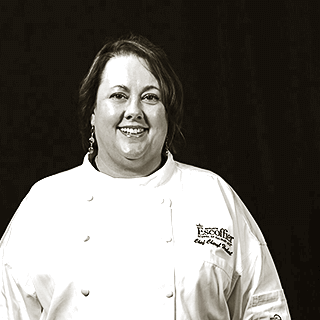Listen to This Article:
With citizens representing cultures from all over the globe, American cuisine has never been defined by a single set of dishes. Instead, it’s a reflection of how people from different backgrounds adapted their culinary traditions to new landscapes, ingredients, and communities.
As people from around the world made their homes across the United States, they shaped local foodways that continue to evolve today. From coastal seafood traditions to hearty Midwestern fare and bold Southwestern spices, each region developed its own signature style.
In the sections that follow, we’ll explore the unique foods that define different parts of the U.S., showcasing regional specialties that reflect local history, geography, and culture.
Why Regional Cuisine Is the Heart of American Food Culture
Ask ten people to define “American food,” and you’ll likely get ten different answers. That’s because the United States doesn’t have a single, unified national cuisine, unlike how other countries’ culinary scenes are known.
Chef Albert Schmid, a lead Escoffier instructor, Gourmand recipient, and culinary historian, explains: “The United States really does not have a national cuisine. It has regional cuisines… The regional cuisines are just incredible here in the United States, and I think they resonate with people because it is something special.”
Each region—whether it’s the seafood-rich Pacific Northwest, the smoky barbecue belt of the South, or the spicy blends of the Southwest—tells its own story through food. These cuisines are often rooted in what the land provides and what families passed down across generations.
For Chef Rodney Smith, southern food is more than a collection of recipes—it’s family history. “I found my lane, which was speaking about where my family comes from,” he shares. “These are meals I remember from when I was younger. We want to elevate them but still respect the ingredients our ancestors used.”
From hush puppies and whole hog barbecue to salmon cooked on cedar planks, regional dishes are a reflection of identity, migration, survival, and innovation. Fast food might be what people recognize coast to coast, but it’s the local dishes that really tell the story of who we are. Learning about regional food isn’t just about what’s on the plate—it’s about the people behind it, the places they call home, and the traditions that have shaped generations.
Best New England Dishes
States: Maine, Vermont, New Hampshire, Massachusetts, Rhode Island, Connecticut
Colonial history and the Atlantic coast shape the cuisine in New England. Because of long, cold winters, the food is hearty and straightforward, built on tradition and local resources. From chowders to baked beans, these dishes reflect generations of tradition and the everyday meals shared in New England homes.
Seafood takes center stage—thanks to the long, rocky coastline—but local produce like apples, cranberries, and maple syrup also shine throughout the seasons. Many New England recipes are about making the most of what’s available and letting quality ingredients speak for themselves.
Root cellars and canning once played a crucial role in helping families survive long winters in this region. That preservation mindset is still evident in today’s pantry staples, such as salted cod, pickled vegetables, and fruit preserves, which have been passed down through generations.
Clam Chowder
Add locally caught clams to potatoes and onions, and you’ve got a soup that ranks among America’s favorites: clam chowder.
There are actually three types of clam chowder: New England is a white clam chowder, which is made with a milk or cream base. Manhattan style is a red clam chowder, which is heavy on tomatoes. And Rhode Island chowder is clear, because it features neither dairy nor tomato.
Lobster Rolls
In keeping with the tradition of seafood-focused meals, another favorite among New Englanders is the lobster roll. This dish simply takes a grilled hot dog bun and replaces a pork sausage with lobster. The roll is often drizzled in butter or lemon juice, smothered in mayonnaise, or topped with salt, black pepper, and scallions.
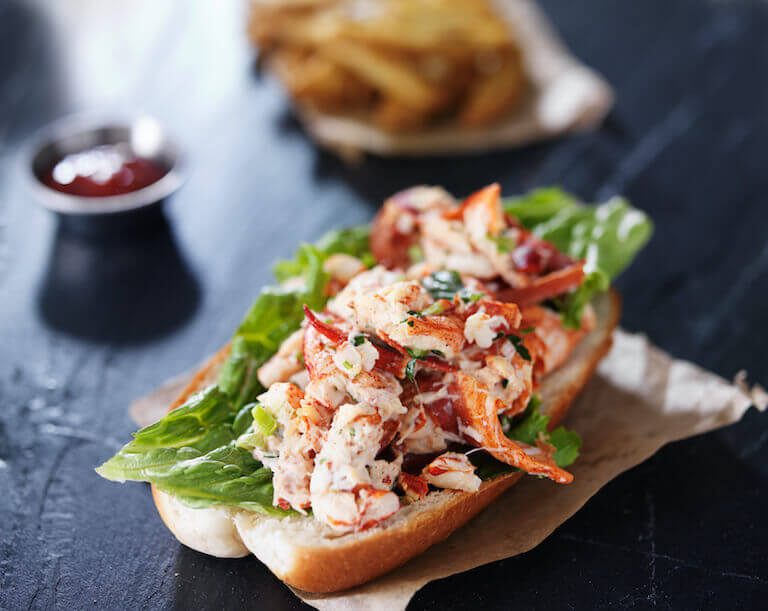
A classic lobster roll—just one of the many seafood staples that define New England’s rich coastal cuisine.
Boston Baked Beans
A longtime favorite in New England, Boston baked beans are made by slowly cooking navy beans with molasses, salt pork, and a small amount of mustard. The result is a sweet and savory dish that’s rich in flavor.
These beans were traditionally baked low and slow in ceramic bean pots, often served on Sundays and paired with brown bread for a classic regional meal.
Best Mid-Atlantic Dishes
States: New York, New Jersey, Pennsylvania, Delaware, Maryland
Mid-Atlantic cuisine reflects the fast pace and cultural diversity of the region’s cities. It’s also shaped by coastal traditions and centuries-old immigrant influence. From New York deli fare to Chesapeake Bay seafood, the food here is bold, accessible, and tied to both street food culture and home-cooked classics.
With roots in Dutch, Italian, German, Jewish, and African American communities, the region is known for iconic dishes that have gone national, but still taste best in their hometowns. Think pizza by the slice, bagels with a shmear, cheesesteaks, and crab cakes fresh from the bay. It’s food made to be shared, eaten on the go, or served up at family gatherings.
Buffalo Wings
Hailing from Buffalo, New York, this creative take on chicken is beloved among sports enthusiasts. Wings have taken off in such a wildly popular way that the once definitive buffalo hot sauce made with cayenne pepper has taken all manner of forms.
There are lemon garlic chicken wings, teriyaki chicken wings, honey sesame chicken wings, and more. Typically, buffalo wings are served with bleu cheese or ranch dressing, and carrots or celery for dipping – all of which cool off a fiery post-wing palette.
Crab Cakes
Crab cakes make excellent fare for events due to their savory taste and convenient snackability. Making crab cakes involves combining crab meat with mayonnaise or mustard, egg, bread crumbs, and seasoning (the exact combination and proportion of spices is a closely guarded secret for many families and businesses). They usually feature blue crab meat, which comes primarily from Chesapeake Bay crabs.
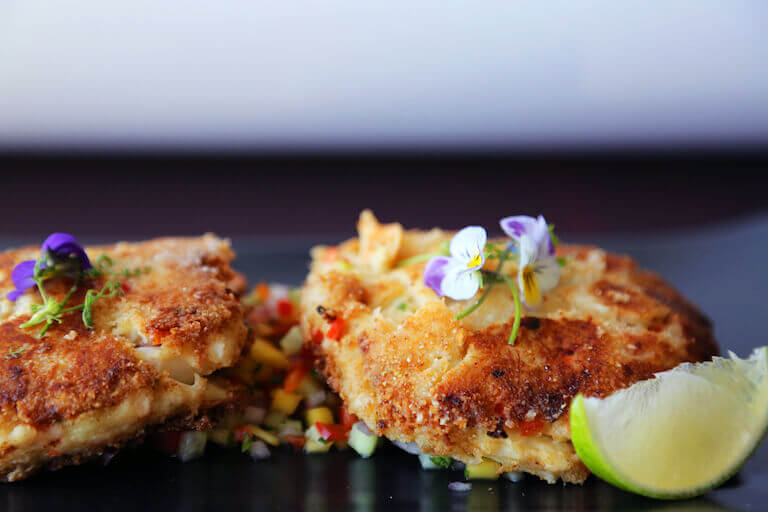
Crab cakes are a Mid-Atlantic staple, capturing the coastal flavors and seafood traditions of states like Maryland and Delaware.
Pork Roll (Taylor Ham)
A breakfast favorite in New Jersey and parts of Pennsylvania, pork roll—often called Taylor Ham in the northern part of the state after its creator, John Taylor—is a salty, slightly spiced processed pork product that’s pan-fried and typically served on a sandwich.
One of the most popular versions is the pork roll, egg, and cheese on a hard roll—especially beloved at diners and delis across the region. Whether you call it Taylor Ham or pork roll depends on where you’re from, and locals will proudly debate which name is correct.
Best Southern Dishes
States: Virginia, West Virginia, Kentucky, North Carolina, South Carolina, Tennessee, Georgia, Florida, Alabama, Mississippi, Louisiana, Arkansas
Southern cuisine is known for its bold flavors, deep history, and unmistakable hospitality. Spanning a wide geographic area, the South includes a range of distinct culinary traditions—from the rice and seafood-based dishes of the Lowcountry, to the spicy stews of Louisiana, to the soul food and comfort classics found in kitchens across the region.
At its core, Southern food is about community and resourcefulness. The cuisine draws heavily from African, Native American, and European influences, with recipes often passed down through generations. Whether it’s a slow-cooked Kentucky burgoo, a basket of golden hush puppies, or a slice of warm pecan pie, Southern dishes tell the story of the people and cultures who shaped them.
Lowcountry Cuisine
Along the coast of South Carolina and Georgia, Lowcountry cuisine reflects a rich blend of African, Caribbean, and European influences. This regional style is known for its use of rice, seafood, okra, sweet potatoes, and cornmeal.
Pastry Chef Cheryl Herbert said, “One of my favorite indigenous cuisines from America is from the Lowcountry, associated with South Carolina and the Georgia Coast.” This is Gullah Geechee, a cuisine style influenced by Western African dishes and made with southern Lowcountry ingredients.
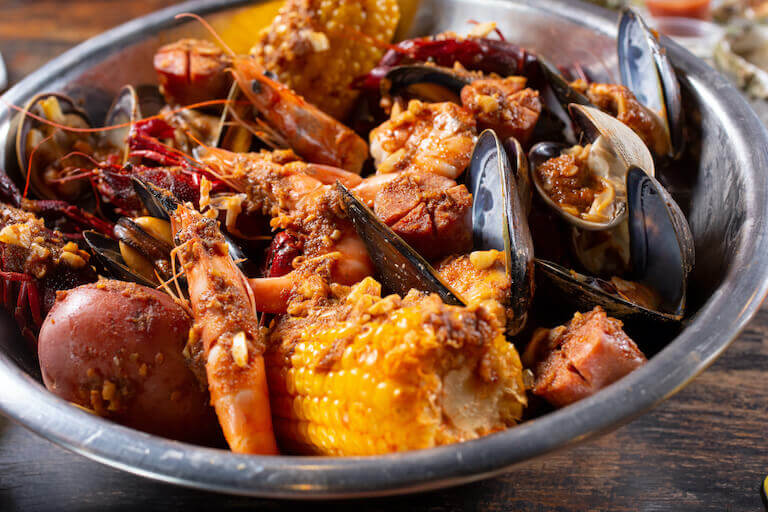
A Lowcountry boil brings together shrimp, crawfish, clams, and corn in one flavorful pot—a Southern coastal tradition rooted in community and comfort.
Some of Chef Cheryl’s favorite dishes include:
- Lowcountry Boil (also called frogmore stew): a one-pot mix of shrimp, sausage, corn, and potatoes
- She-crab soup: a creamy bisque made with crab meat, crab roe, and sherry
- Chicken perlau: a hearty stew of chicken, sausage, and rice
- Gullah-style corn cakes: cornmeal cakes fried with celery, onion, and corn
- Pimento cheese: a tangy, creamy Southern staple often served with crackers or bread
These dishes showcase the depth, warmth, and cultural roots of coastal Southern cooking.
Cajun & Creole Cuisine
French cuisine was a big influence in the cuisine of Louisiana, which led to modern day Cajun and Creole food. While Creoles descended from French and Spanish settlers in colonial Louisiana, Cajun cuisine comes from the French colonists who settled in Canada’s Acadia region before making their way to Louisiana. These two cuisines are quite distinct, but both include plenty of spices and frequent use of the “holy trinity” of onions, bell peppers, and celery.
Signature dishes include:
- Gumbo: a hearty stew made with roux, meat or seafood, and okra or filé powder
- Jambalaya: a one-pot rice dish with sausage, chicken, shrimp, or all three
- Etouffée: a smothered seafood or meat dish often served over rice
- Red beans and rice: traditionally cooked on Mondays with leftover pork
Chef Albert Schmid says, “I am very fond of Cajun and Creole cuisines from Louisiana.” Some of his favorites include beignets for breakfast—fried dough sprinkled with powdered sugar. Another favorite are Oysters Bienville, baked oysters in a shrimp sauce. For dessert, he loves bread pudding with whiskey sauce.
Floribbean
Combine the diverse culinary traditions of Caribbean, Hispanic, and Asian cultures and you’ve got the cuisine known as Florribean. It’s lighter than traditional Southern fare but still packed with bold spices and tropical ingredients.
This regional style often features citrus, mango, plantains, seafood, heart of palm, and fresh herbs, drawing influence from Cuban, Jamaican, Haitian, and Southeast Asian cooking traditions.
Popular dishes include:
- Swamp cabbage salad (or heart of palm salad): a dish with many variations, it often includes heart of palm, shredded vegetables, and a dressing
- Shrimp and grits with tropical spices: grits, made from ground corn, are usually coarser than cornmeal or polenta. When the grits are turned into a porridge, often with cheese, and combined with shrimp, coriander, paprika, and other spices, this dish becomes an instant comfort food
- Key lime pie: a citrusy pie made with condensed milk
Floribbean food reflects the cultural diversity of South Florida and the bright, sunny climate it comes from.
Soul Food
Soul food is a deeply rooted part of African American culture and Southern history. It developed from the creativity and resilience of enslaved people and their descendants, who turned modest ingredients into rich, flavorful meals that nourished both body and spirit.
These dishes are often made with staples like cornmeal, greens, pork, beans, sweet potatoes, and rice—prepared in ways that reflect resourcefulness, tradition, and family ties.
Classic soul food favorites include:
- Fried chicken with a golden, seasoned crust
- Collard greens simmered with smoked meat
- Black-eyed peas, candied yams, and cornbread
- Hush puppies—crispy cornmeal fritters often served with fried fish
- Macaroni and cheese baked until bubbly
- Banana pudding and sweet potato pie for dessert
More than just food, these dishes are a celebration of heritage and a lasting symbol of home, family, and community.
Appalachian Cuisine
In the mountains of Kentucky, West Virginia, Tennessee, and parts of North Carolina, Appalachian cuisine reflects generations of cooking shaped by self-reliance, seasonal eating, and preserving what’s on hand. The food is simple, hearty, and often made from ingredients grown, foraged, or cured at home.
Core staples include beans, cornmeal, apples, wild greens, pork, and sorghum, with techniques like canning, pickling, and drying still playing a role in many kitchens today.
Classic Appalachian dishes include:
- Soup beans and cornbread: a filling, everyday meal in many mountain homes
- Biscuits and gravy: soft, flaky biscuits smothered in sausage gravy
- Fried hand pies: small pastries filled with fruit or sweet potato
- Apple stack cake: a traditional celebration cake made with dried apples and thin cake layers
These dishes speak to the creativity and care of mountain cooks who knew how to make the most of what the land and seasons provided.
Best Midwest Dishes
States: Ohio, Michigan, Indiana, Illinois, Wisconsin, Minnesota, Iowa, Missouri, North Dakota, South Dakota, Nebraska, Kansas
Often called “America’s Heartland,” the Midwest is known for its comfort food, agricultural heritage, and immigrant influences—especially from German, Scandinavian, Polish, and Czech communities. The food here is hearty, practical, and often built around locally grown staples like potatoes, beef, corn, and dairy. It’s the kind of cooking that brings people together around casseroles, pies, and game day snacks.
Toasted Ravioli
Crunchy on the outside, warm and savory on the inside—toasted ravioli is St. Louis comfort food at its finest. Unlike the traditional boiled version, these ravioli are breaded, fried until golden, and typically stuffed with a hearty beef or cheese filling. Legend has it they were created by accident in a kitchen on The Hill, St. Louis’ historic Italian-American enclave. Whether or not the origin story is true, one thing is certain: this dish has become a local icon, served at everything from casual get-togethers to fine dining spots across the city.
Buckeyes
Buckeyes, named after the state tree of Ohio, consist of a ball of peanut butter coated in chocolate. But though this confection may sound simple, don’t be fooled. Getting buckeyes to come out with the right consistency and a perfect circle of peanut butter exposed at the top takes a lot of pastry finesse. Arguably the best thing about buckeyes? They can be frozen for months for later enjoyment!

Buckeyes—chocolate-dipped peanut butter balls—are a sweet symbol of Midwest tradition and Ohio pride, especially popular during the holidays.
Other popular Midwestern dishes include:
- Hotdish: A hearty casserole made with ground beef, canned soup, and tater tots
- Cheese curds: Fresh or deep-fried bites of squeaky cheese, especially popular in Wisconsin
- Coney dogs: Chili-topped hot dogs finished with mustard and diced onions, famous in Michigan and Ohio
- Runza: A soft bread pocket filled with ground beef and cabbage, popular in Nebraska
- Pasties: Savory hand pies filled with meat and potatoes, brought to Michigan by Cornish miners
These dishes may be humble, but they reflect the heart of the Midwest—practical, comforting, and meant to be shared.
Best Southwest Dishes
States: Texas, New Mexico, Arizona, Oklahoma
The food of the Southwest is bold, flavorful, and shaped by both the land and its history. Influenced by Mexican, Native American, and ranching traditions, Southwestern cooking makes the most of ingredients like chilies, corn, beans, beef, and tortillas. Many dishes are slow-cooked, smoky, and built to bring people together—whether around a campfire or a family table.
Chili
Chili was born where cattle drives meet Mexico, which makes it the perfect food to meld these two cultures, and to represent the American Southwest – specifically Texas. The need to create a dish that was hearty, tasty, and used what was available is why chili was created. The low and slow cooking allows the meat to become nice and tender. The melange of aromatics and chilies give the dish a rich and complex flavor.
Fry Bread
A Native American culinary tradition, fry bread became common across Navajo Nation during the tribal displacements of the mid 1800s. The dish is made from a pillowy dough, served warm, and often topped with honey and powdered sugar.
Tex-Mex Cuisine
Tex-Mex is one of the most recognizable and widely loved styles to come out of the Southwest. It blends Mexican cooking traditions with American ingredients and techniques, resulting in bold, cheesy, satisfying dishes found everywhere from home kitchens to chain restaurants.
Popular Tex-Mex staples include:
- Fajitas: grilled meat and vegetables served sizzling with tortillas
- Queso: melted cheese dip, often spiked with chilies or ground beef
- Chimichangas: deep-fried burritos packed with meat, cheese, and beans
- Enchiladas and tacos: served with shredded beef, sour cream, and plenty of spice
Tex-Mex may not be traditional Mexican food, but it’s its own beloved category with roots that run deep in Texas and beyond.
Best Rocky Mountain Dishes
States: Montana, Idaho, Colorado, Utah, Wyoming, and Nevada
In the Rocky Mountains, food tends to reflect the way of life—rugged, practical, and shaped by the outdoors. Meals often center around wild game, open-fire cooking, and hearty, no-fuss ingredients. Whether it’s a grilled bison burger or a cast-iron stew, Rocky Mountain dishes are rooted in tradition and built to satisfy after a long day on the land.
Dutch ovens, cast iron pans, and open-fire cooking are still staples in many kitchens—echoing the region’s long tradition of cooking in the wilderness.
Bison Burgers
Classic Rocky Mountain fare includes gamey meats like elk, venison, or bison. Bison patties are a particularly popular take on the standard American burger. They’re juicy, taste remarkably similar to beef, and are healthier – being significantly lower in fat and calories than ground beef.
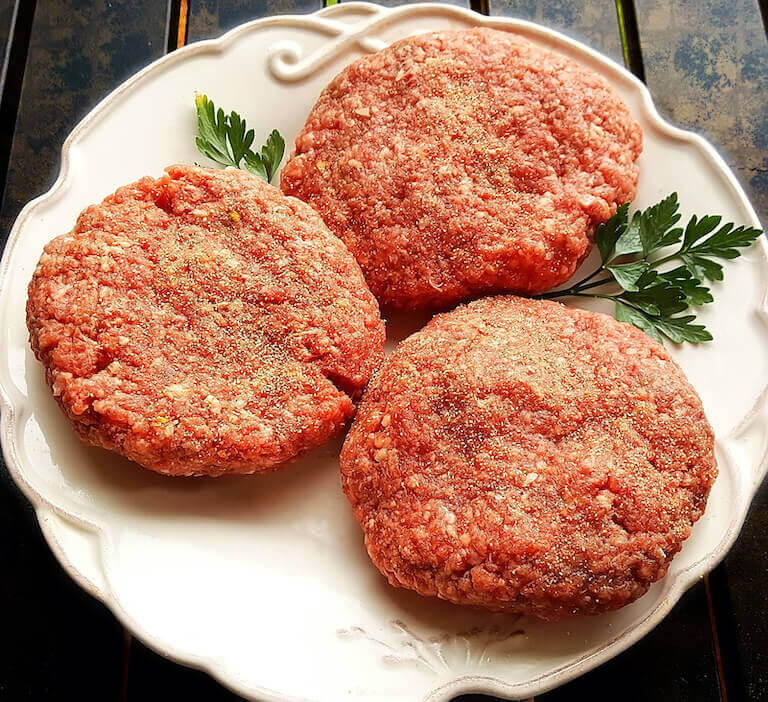
Bison burgers, a Rocky Mountain favorite, highlight the region’s love for wild game and lean, flavorful meats sourced close to home.
Rocky Mountain Oysters
No, these aren’t seafood after all. Considering that Rocky Mountain oysters, also known as prairie oysters, are served primarily in landlocked states, they do in fact come from land-dwelling creatures. Rocky Mountain oysters are made of bull or bison testicles, either deep fried or pan fried, and typically drizzled in lemon juice.
Other beloved Rocky Mountain dishes include:
- Elk stew: A rich, slow-simmered dish with tender elk meat and root vegetables
- Pan-seared trout: Fresh-caught from mountain streams and simply prepared with herbs and butter
- Huckleberry pie: A sweet, tangy dessert made from wild mountain berries
- Lamb with rosemary and garlic: A nod to local sheep ranching, often grilled or roasted
- Dutch oven potatoes: Sliced potatoes cooked low and slow with onions, butter, and cheese over an open flame
Best Pacific Coastal Dishes
States: California, Oregon, and Washington
The West Coast serves up food that’s fresh, flavorful, and full of variety. Thanks to the nearby ocean and fertile farmland, ingredients don’t have to travel far—which means meals often showcase whatever’s in season. Whether it’s seafood straight off the dock, produce from a weekend market, or globally inspired dishes, West Coast cuisine is all about bright flavors and creative combinations.
Fish Tacos
Just like on the nation’s east coast, seafood has a prominent role in west coast dishes. The fish taco is said to have originated in Baja California, Mexico, before making its way up the coast, through California, and subsequently all across the country.
Fish tacos are usually served with a flaky white fish like grouper, flounder, cod, or mahi mahi. They can come fried, blackened, or grilled, and served with a variety of toppings.
Cedar Planked Salmon
What happens when you cook fish on top of a wood plank? The smokey flavor of the wood permeates the meat, infusing a delightfully smoky taste throughout it.
As far as fish go, salmon is particularly abundant in the Pacific Northwest, and the red cedars of Oregon and Washington tend to be the preferred wood to use for this dish. However, wood-smoking has become widespread across the world, with other types of meats and even vegetables being cooked on hickory, mesquite, oak, and other woods.
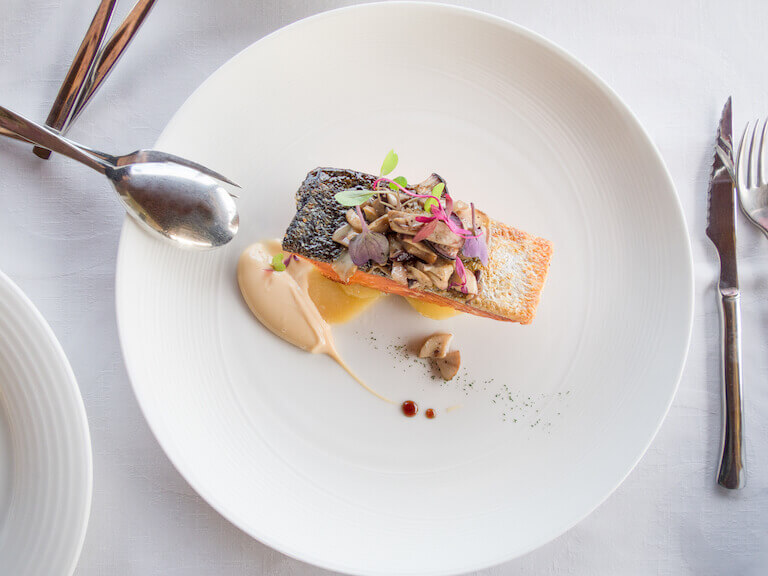
Fresh, vibrant, and full of coastal flavor, salmon dishes like this one represent the Pacific Coast’s emphasis on seasonal ingredients and ocean-to-table cooking.
Other popular West Coast dishes include:
- Dungeness crab: Sweet, tender crab often steamed or served cold with drawn butter
- Avocado toast: A simple but iconic dish made with ripe avocados, crusty bread, and toppings like chili flakes, radish, or poached eggs
- Hangtown Fry: A historic California dish made with eggs, bacon, and fried oysters, once considered a gold rush-era delicacy
- Sourdough bread: Especially associated with San Francisco, known for its tangy flavor and chewy crust
- Seasonal veggie grain bowls: A staple of California cuisine, featuring grains like quinoa or farro topped with roasted vegetables, nuts, seeds, and vinaigrette
Exploring Culinary Traditions
The regions that make up the United States are only a small fraction of the world. With so many different types of cuisines, exploring culinary traditions around the globe could certainly take a lifetime!
Fortunately, you may get a small taste of many American cuisines, as well as other global culinary traditions, in culinary school. Courses like American Regional Cuisine or Western European Cuisines at Escoffier may be included in the culinary arts curriculum and can provide students with cultural histories, key ingredients, cooking styles, characteristics, and recipes of a variety of regional gastronomy.
And these are but two courses in the Culinary Arts curriculum! There’s so much to discover through a culinary degree or diploma program at Escoffier. Reach out to an Admissions Advisor to find out more about a comprehensive culinary education and how you can find your niche.
WANT TO READ MORE ABOUT THE WORLD OF FOOD AND DRINK?
- America’s Most Budget-Friendly States for Foodies
- What Is Fusion Cuisine?
- America’s Most Diverse Food Cities: Ranking the Culinary Diversity of the Largest Cities
This article was originally published on February 17, 2022, and has since been updated.

